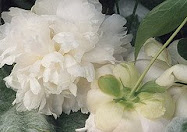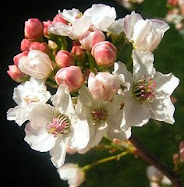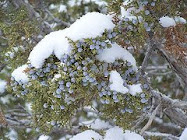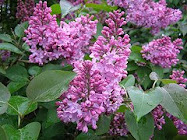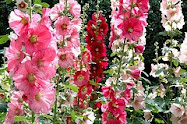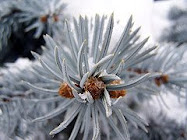

 Yuck and horrors, they are everywhere! Drive the country roads, highways, village streets of northwestern Michigan this spring, and nary a stretch can be found without trees, in the hundreds of thousands, hosting the triangular, silky white pouch nests of the eastern tent caterpillar. Hosting by brute force that is, not by choice, as tent caterpillars are an invading, parasitic horde who feed off and destroy the trees in which they set up camp. Across farm fields, meadows and hillsides, swathes of denuded, dying trees blot the landscape, the swollen caterpillar pouches the only remaining signs of life on their limbs.
Yuck and horrors, they are everywhere! Drive the country roads, highways, village streets of northwestern Michigan this spring, and nary a stretch can be found without trees, in the hundreds of thousands, hosting the triangular, silky white pouch nests of the eastern tent caterpillar. Hosting by brute force that is, not by choice, as tent caterpillars are an invading, parasitic horde who feed off and destroy the trees in which they set up camp. Across farm fields, meadows and hillsides, swathes of denuded, dying trees blot the landscape, the swollen caterpillar pouches the only remaining signs of life on their limbs.Tent caterpillars hatch from egg sacs laid by adult moths the previous year, usually wriggling to life around early March. A greyish-black, hairy creature with a single yellow stripe along its back from head to tail, after sloughing off the egg, the tent caterpillar weaves its homesite pouch in the forks of tree branches or trunks. They leave the pouch to feed, usually in the early morning or early evening hours, and what they feed upon are the leaves of the host tree. As the caterpillars consume leaves, they enlarge their pouch and build subsidiary ones, with the pouches sometimes reaching a length of over a foot. Voracious little eaters, they can completely defoliate a moderate-size ornamental fruit tree in a couple of weeks.
Approach a tent caterpillar nest and through the nest membrane you can clearly see hundreds of the critters slithering about, probably doing a little worm-dance celebration of their good culinary fortune. Their favorite food is the leaves of wild cherry trees, with crab apples and eating apples coming a close second, very bad news for counties like this one, where cherry and apple trees abound. Failing the choice of these species, they will also colonize and chew the life from peach trees, sweet cherry, plum, pear, hawthorn, maple and birch.
In four-to-six weeks after spinning their nest, the caterpillars reach full-grown size of three or four inches, and wander off from the pouches to spin the one-inch long, white or yellowish cocoon they will inhabit while transforming themselves into an adult moth. The pale cinnamon brown moth, with two cream-colored horizontal stripes across each wing, emerges from the cocoon after about three weeks. The adult moths then mate, lay new eggs that will generate more tent caterpillars the following springtime, and expire. The egg sacs are shiny, dark greyish white, about one inch long, and have a hard casing like fossilized foam. They will be laid on the the twigs or trunks of trees, the walls of buildings, porch railings, and adhere to the laying site throughout the winter. One egg sac can yield up to 400 caterpillars.
Tent caterpillars pose no threat to humans, nor to any plants other than the trees in which they nest. They do not bite, sting, nor carry disease, they're not poisonous, they don't attack or eat any other plant besides trees. Other than imperiling the health and well-being of trees, they are largely just a blight upon the landscape and a nuisance pest. When the full-grown caterpillars set off from the home pouch to establish their own cocoons, they litter plants, walkways, driveways, even nearby vehicles, leaving slimy trails behind them and exploding, if stepped upon, into a gooey, slippery mess. They seem to bestow not one whit of good upon the environment to compensate for the havoc and ugliness they wreak, as birds or other possible food-chain predators don't fancy them much nor make enough of a meal of them to control their spread.
The natural resources office at the Sleeping Bear Dunes Park doesn't regard tent caterpillars as an actionable menace, despite the fact that many thousands of trees in the park are being assaulted by them this spring. A park spokesman noted that the caterpillar populations fluctuate from year to year in size of outbreaks, one year being widespread and then declining in the next year. Healthy trees, he posited, even when scalped of all their spring leaf growth, will often recover and grow new leaves by mid-summer. Holding this view, the national park will stand back and let nature take its course with the tent caterpillars, not making any effort to halt their rabid ways or come to the aid of the woeful trees.
To be fair, the park service, and county forestry departments, don't really have any good options for fighting tent caterpillar infestation across acres of woodlands. Even if they had the money to spray miles upon miles of infected land with pesticide, which they do not, even if they were willing to contaminate many beneficial insects, butterfly caterpillars, and plant life in shotgun-style poison spraying, which they absolutely should not, pesticides aren't very efficacious at destroying tent caterpillars. There are some wasp species and bacteria which can eliminate tent caterpillars, but these require individual, painstaking, tree-by-tree application, a process which is unfeasible for a pest that colonizes hundreds of miles of trees.
The private gardener, fortunately, does have an effective, easy recourse for eradicating these little tree-killers. Personally, I don't buy the year-by-year fluctuation, nature-can-deal-with-it, hands-off approach. A tent caterpillar pouch debuted last spring in my crab apple tree, and despite being promptly and thoroughly (I think) dispatched by my hand to oblivion, another pouch popped up in the fork of the same tree this spring. What's more, pouches were also woven this year in the young crabapple and cherry trees in several of my neighbors' yards.
Maybe a strong, adult, healthy tree that enjoys lots of water each year and mild wintertimes can, indeed, pull off a comeback after its first crop of young leaves are completely devoured. Or maybe not. There are stands of trees all over the county that have seen several continuous years of cannibalistic beseigement by tent caterpillars, and which are now clearly expiring. The winters are frost-heavy and tough around here, the summers can bring sustained periods of drought, and setting out new leaves in summer to replace stripped branches takes an enormous amount of energy, further depleting a tree's strength and resources for onward, healthy progress.
My crabapple and those of my neighbors were given a helping human hand. Purging a tree or two or three of tent caterpillars in private gardens is a quick and simple task. All one needs do is get rid of the nests and the dratted caterpillars in one fell, fatal swoop. Striking around noontime, in the heat of the day, will find them least active and lollygagging inside the pouch. Put on a pair of gloves to protect the hands from the necessity of touching the critters, or getting unappealingly slimed. Take a bucket and put an inch or so of rubbing alcohol in the bottom. Using the hands, the pouches can easily be pulled off the tree bark, into the bucket. Scrape any loose or escaping caterpillars into the bucket, and rub all remnants of the pouch silk off the tree bark. Check the ground beneath the tree and the branches around the pouch for other escapees, and deposit them in the bucket. As soon as the caterpillars hit the alcohol, they perish.
If there are more caterpillars than the alcohol can submerge, or it any wrigglers persist after dousing, take a kettle of boiling water, pour it atop the survivors, and it will polish them off for good and all. If your homicidal impulse remains unsatisfied, crush the sodden mass in the bucket with the back of a trowel until nothing remains but pureed caterpillar soup. This can be dumped down a garbage disposal if you really want to see the back end of it forever, or, once the caterpillars are well and truly dead, simply thrown into a ditch.
Watch for the hard-foam egg sacs on branches and elsewhere in your garden through summer, and they are easy to break off, crush and burn to prevent a return engagement next year. In such manner, the gardener can assist nature to deal with one of her more deviant, destructive creatures, and preserve and protect the precious fruit trees that bring a froth of lacy blossoms each spring, and food for birds, people and animals all summer and fall. Some actors on nature's stage just cannot be tolerated for repeats of their dismal performances, nor must the good gardener sit passively by, repelled and appalled, while their greedy premiere broadside plays out.


 “The misunderstanding I have with Nature over my perennial border,” writes gardener Sara Stein, “I think it is a flower garden. She thinks it is a meadow lacking grass, and tries to correct the error.” A similar misunderstanding and attempted “correction” plays out in my garden every year. Since the garden is meant to cover the whole of the lot, however, the annual war of the grass weeds is fought across the entire yard, not just in borders.
“The misunderstanding I have with Nature over my perennial border,” writes gardener Sara Stein, “I think it is a flower garden. She thinks it is a meadow lacking grass, and tries to correct the error.” A similar misunderstanding and attempted “correction” plays out in my garden every year. Since the garden is meant to cover the whole of the lot, however, the annual war of the grass weeds is fought across the entire yard, not just in borders.